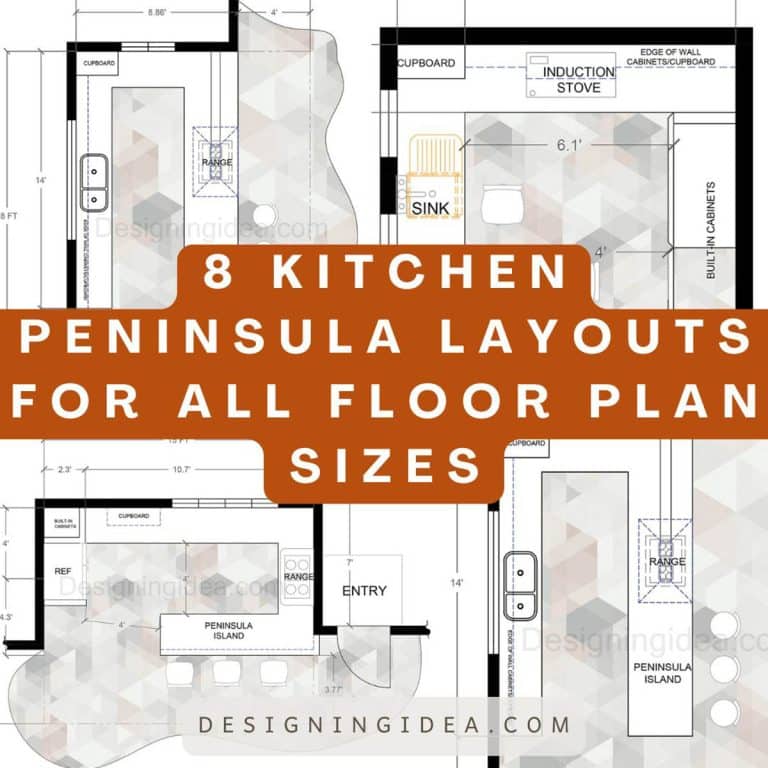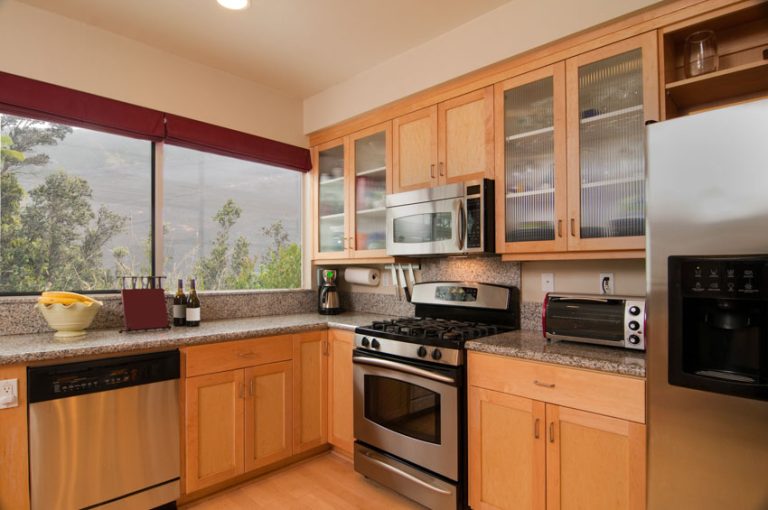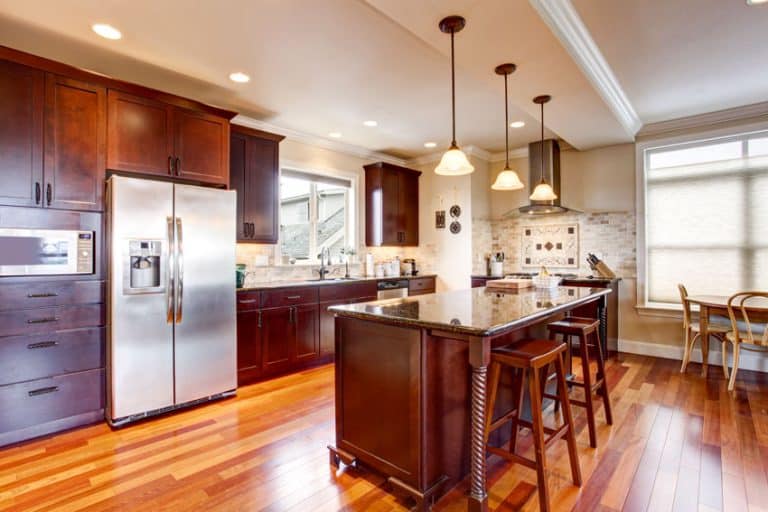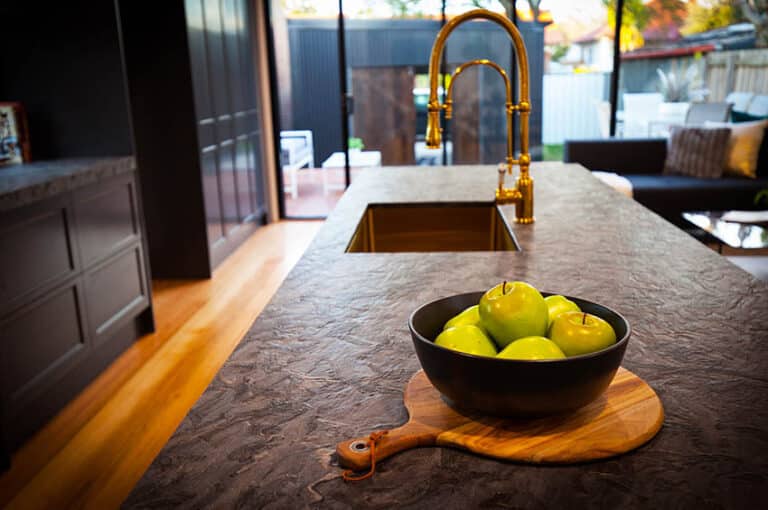How To Design Craftsman Kitchens with Beautiful Cabinets & Finishes
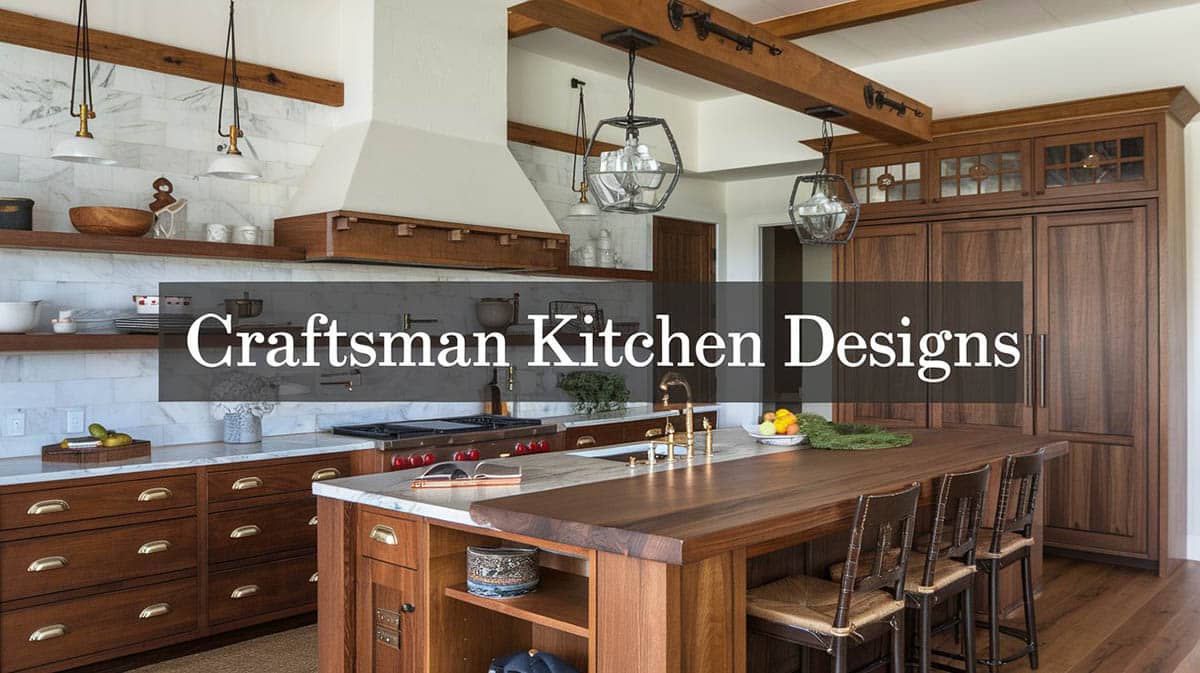
The Craftsman design style is known for its clean lines, rich wood cabinetry, and quality construction. Craftsman kitchen cabinetry relies on natural wood rather than artificial materials. The types of wood often used for cabinets include oak, hickory, maple, and cherry. The overall design aesthetic of Craftsman kitchens is traditional, with simple, custom-crafted elements and high-quality materials.
This kitchen uses a combination of two finishes for the kitchen cabinets. The main cabinets uses natural teak wood finish, while the large kitchen island uses white wash finish over the wooden cabinets. All counters were topped with white marble for an elegant look. Right above the kitchen island is an accent ceiling design, with a recess the same size as the island, and decorative wooden beams. It also has skylights to help bring in more light to the space.
Characteristics Of A Craftsman Style Kitchen
What is the Craftsman style? To understand the design sensibilities of the Craftsman-style kitchen, let us take a look at its origin first. The Craftsman style originated in England during the 19th century as a result of the Arts and Crafts Movement. The Arts and Crafts movement was an international movement that aimed to reform design and decoration and stood for traditional craftsmanship. Machinery and factory production were prevalent during that era, thus causing a decline in standards in design and the use of materials that are artificial and of low quality.
Consequently, in reaction against the intricately decorated and mass-produced furniture of the Victorian era, the Craftsman style was born. Following the main principle that “utility must have precedence over ornamentation”, it placed priority on functionality above everything else. And unlike the ornate details of a Victorian-inspired design, the Craftsman style put great premium on simplicity and gave more emphasis to Craftsmanship. Although utilitarian in nature, the Craftsman style still became one of the most visually captivating and stand-out design styles in history. It is the perfect marriage of form and function.
Overall, the Craftsman-style kitchen is defined by three basic principles: a straightforward design with clean lines, high-quality construction, and minimal ornamentation.
Craftsman Kitchen Design
The Craftsman kitchen design is more geared towards an overall traditional style or antique look. It is the perfect addition to traditional inspired homes like a country home, bungalows or cottages. What elements make up a Craftsman-style kitchen? There are a number of design features that make up a Craftsman-style kitchen.
Here are some of the elements that make a Craftsman-style kitchen stand out from the rest:
Solid wood cabinetry in rich colors – The main material that is on display in a Craftsman-style kitchen is solid wood. Instead of using artificial materials, a true Craftsman-style kitchen makes use of heavy woods such as oak, cherry, maple, pine, and hickory. The most popular wood used is oak. The Craftsman style puts emphasis on the natural beauty of wood by showcasing exquisite cabinetry and simple millwork. Aside from featuring excellently crafted details, the wood is also usually finished in a deep-colored stain. It can also be left unpainted, allowing the inherent grain pattern and distinct aesthetics to stand out.
Clean lines and no-fuss design for the cabinetry – A Craftsman-style kitchen is generally straightforward when it comes to its design. It also favors function more than an overly ornate design. It does not focus on heavily carved details or elaborate ornamentation but instead highlights high-quality craftsmanship. Instead of showcasing carvings, it features joinery instead. Cabinetry is usually frameless or features simple aesthetics like flat paneled doors or simple framed glass doors.
A neutral color palette – Craftsman style kitchens also take inspiration from nature which is why its color palette is usually composed of warm earth tones. Typical color schemes include shades of browns and tans and shades of green like rich moss greens or forest greens. Other popular accent colors are rich honey tones, gold, rust, and deep oranges. Read on as we go deeper into the details of a Craftsman-style kitchen color palette.
Natural Stone Finishes – Because Craftsman-style kitchens draw inspiration from nature, they seldom use synthetic materials for their finishes. Natural stone is another material that is commonly used in Craftsman-style kitchens. It is usually applied as a backsplash material, countertop, or flooring. Some types of natural stones that can be used for this application are granite, soapstone, slate, travertine, etc. Just like wood, the inherent and distinct beauty of natural stone conforms to the genuine aesthetics of a Craftsman-style design.
Features unornamented and streamlined lighting fixtures – The emphasis that a Craftsman kitchen gives to functionality is also reflected in the choices of lighting fixtures. Craftsman-style lighting fixtures, pendants, and drop lights have strong lines and geometric shapes. It typically makes use of metal and keeps the kitchen not only well-illuminated but also gives off a warm and cozy ambiance. Read on as we discuss Craftsman-style kitchen lighting in full detail.
Built-in breakfast nook – To highlight craftsmanship further and to maximize the kitchen to its fullest functionality, Craftsman-style kitchens also often include a form of built-in seating. The practical benefit of such is that it eliminates the need for additional furniture pieces like a table and some chairs. A small breakfast nook that features a solid wood bench and a dining table serves as a seating area for casual dining and entertaining with family or friends.
Unique backsplash – The only decorative element used in Craftsman-style kitchens is the backsplash, and along with countertops and islands, the kitchen backsplash is one of the stand-out features in this design. The most common material used as a backsplash for Craftsman-style kitchens is tiles. These tiles are commonly handcrafted and painted with rich details. Read on as we explore some other options that you can use as a backsplash for your very own Craftsman-style kitchen.
Hardware and fixtures in deep or dark finish – The Craftsman-style kitchen gives its own unique touch, even up to the small detail in your kitchen design. The “jewelry of the kitchen” or cabinet hardware like handles, knobs, and pulls must also be geared towards functionality. These should be easy to grip and are usually large. When it comes to design, cabinet hardware typically has a strong architectural style and defined lines.
Because wood is abundant in this style of cabinetry, you may want to consider antique accessories. Cabinet hardware, faucets, and other fixtures typically have deep and warm finishes. These include oil-rubbed bronze, antiqued brass, warm patinas, and dark-colored brushed antiques. Black metal hardware and pulls are also popular for this style. Avoid shiny finishes for a Craftsman-style kitchen as they lean towards a more modern look.
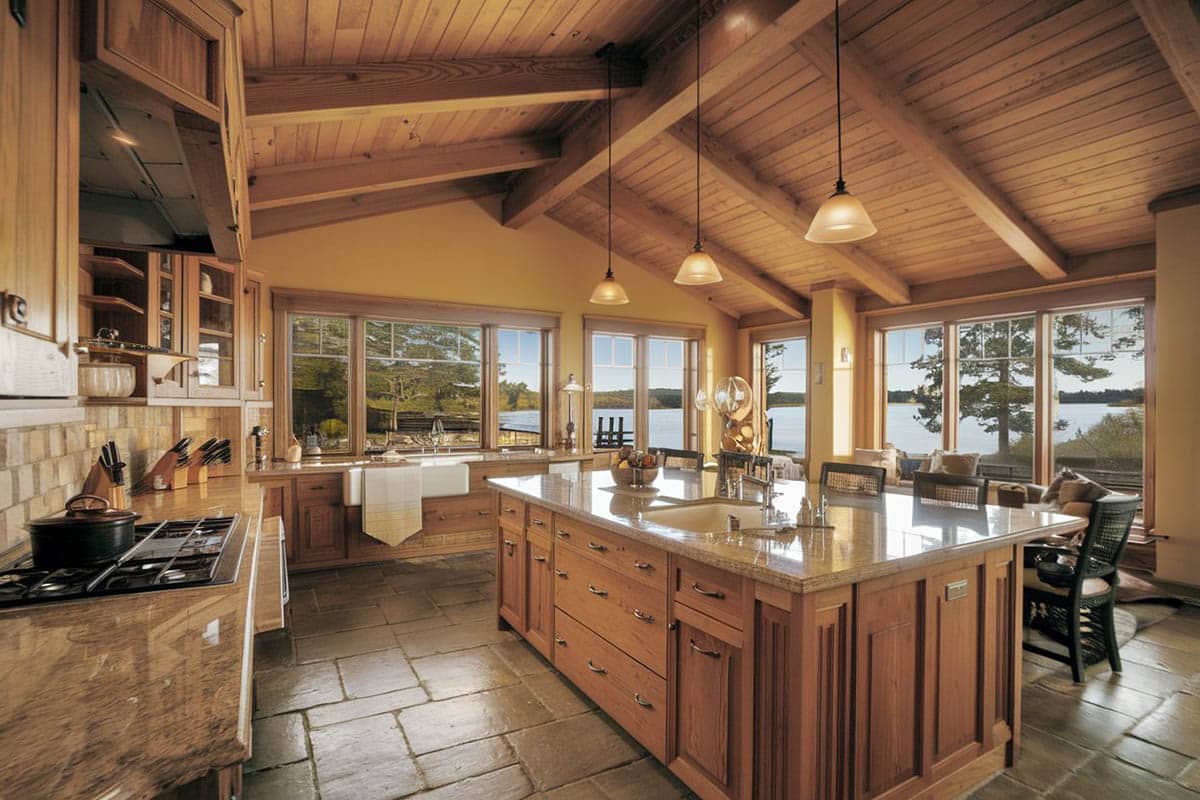
This solid teakwood kitchen has a gorgeous vaulted ceiling design with exposed beams and trusses. Picture windows envelop the kitchen space and provide stunning views of the ocean. The kitchen area is typically damp, so instead of hardwood floors, this space opted for wood-finish ceramic tiles. All of these were topped with gray azurite granite for a more laid-back appeal.
Kitchen Cabinets in Craftsman Design
The main attraction of a Craftsman-style kitchen is the stunning cabinetry. The craftsman of artisan kitchen style originated in the early 1900s and is focused on a deep appreciation for handcrafted custom cabinetry with warm wood tones and an open floor plan. Craftsman-style kitchen cabinets are characterized by functionality, high-quality construction, and superior sturdiness.
In addition to that, Craftsman kitchen cabinets are all about authentic details. Solid wood was always used, and artificial materials were never utilized. Quarter-sawn oak with its beautiful graining, cherry, and maple woods are traditional favorites used in Craftsman-style cabinets. These solid wood cabinets are typically left unpainted and true to their natural state, allowing their inherent distinct beauty to stand out. In order to enhance the undertones and the rich color of wood, stain can also be applied on its surface.
Generally, square straight edges are used with either a flat or raised panel cabinet door design. Leaded glass doors are also common in Craftsman architecture. It’s the small details such as decorative molding, valances, corbels, and period hardware that really bring out the attention to detail that is characteristic of Craftsman kitchens.
True craftsmanship is also achieved through the use of different joinery techniques in building the cabinets. Some joinery that are featured in this type of cabinet are dovetail joints, mortise and tenon joints, miter joints, and butt joints. Dowels can also be used instead of nails.
Quality construction, a sturdy build, and exquisite woodwork can be achieved through employing professional custom cabinet makers. Rather than building a Craftsman-style kitchen as a “do it yourself” project, it requires the services of an experienced craftsman. This is also one of the reasons why Craftsman-style cabinets and Craftsman-style kitchens can get a bit pricey. The materials which make use of high-quality wood and the installation costs are both expensive and the cabinetry takes a big percentage of the budget. Thus, when deciding to create one for your home, make sure that a sufficient budget is allocated for your project.
However, if you still want to create Craftsman-style kitchen cabinets but do not want to spend much, modern alternatives to traditional woodwork can be used. Some homeowners make use of readymade or prefabricated versions of these cabinets. Alternatively, hardwood veneer can also be used to achieve the Craftsman look for less.
Craftsman Backsplash Designs
As mentioned earlier, the only decorative element in a Craftsman-style kitchen is the backsplash. Since the cabinetry is all about simplicity and functionality, the backsplash offers the perfect opportunity to introduce an accent or decor to a Craftsman-style kitchen. The backsplash breaks up all the monotony of the heavy woodwork and gives the space an eye-catching accent. There are a number of backsplash materials that can be explored for a Craftsman-style kitchen, and this includes artisan tiles and several types of natural stone.
During the Arts and Crafts movement, fine tile-making reached its peak. Consequently, handmade artisan tiles took center stage when it comes to backsplashes. Traditional Craftsman-style tiles are created using handmade molds and are typically colored with natural glazes. Artisan tiles were usually hand-painted with floral motifs or scenes that depicted nature or were inspired by Art Nouveau. These hand-painted tiles are commonly in shades of blue or green, which gives a stark and cool contrast to the rich, warm tones of wood. Nowadays, handcrafted tiles are quite rare to find, making them quite expensive. However, its exquisite beauty makes its price worth every penny.
Aside from hand painting, another common finish for tiles is glazing. Glazing gives tiles a worn layer of glass, which results in their glossy appearance. Glazed tiles are a perfect match to the matte finish of solid wood cabinetry because they provide diversity and variation in texture. Glazed tiles are also available in many tones and hues. Aside from glazing, tiles can also be etched or carved with a custom design, such as small leaves, flowers, or nature-inspired details, to give them depth and a more interesting look.
Natural stone backsplashes are also common for Craftsman-style kitchens. Slate is an example of natural stone which can be used for Craftsman-style kitchens. Characterized by a bluish, green, gray, and rust color, slate adds warmth to kitchens when used as a backsplash. Its earth-toned color makes it the perfect complement to rich solid wood cabinets, while adding a subtle touch of accent color to the palette of the kitchen. A slate backsplash also blends well with the antique and traditional inspiration of a Craftsman-style kitchen.
Travertine is another natural stone that can be used as a backsplash material for Craftsman-style kitchens. It is made of limestone and is usually light-colored or creamy, beige, or white. It also has warm undertones, which are brown or tan in color, and serves as the perfect complement to rich dark woods. This is highly suitable for those who want to create a subtle contrast using light colors. Just like slate, travertine is perfect for the antique and traditional inspiration of a Craftsman-style kitchen.
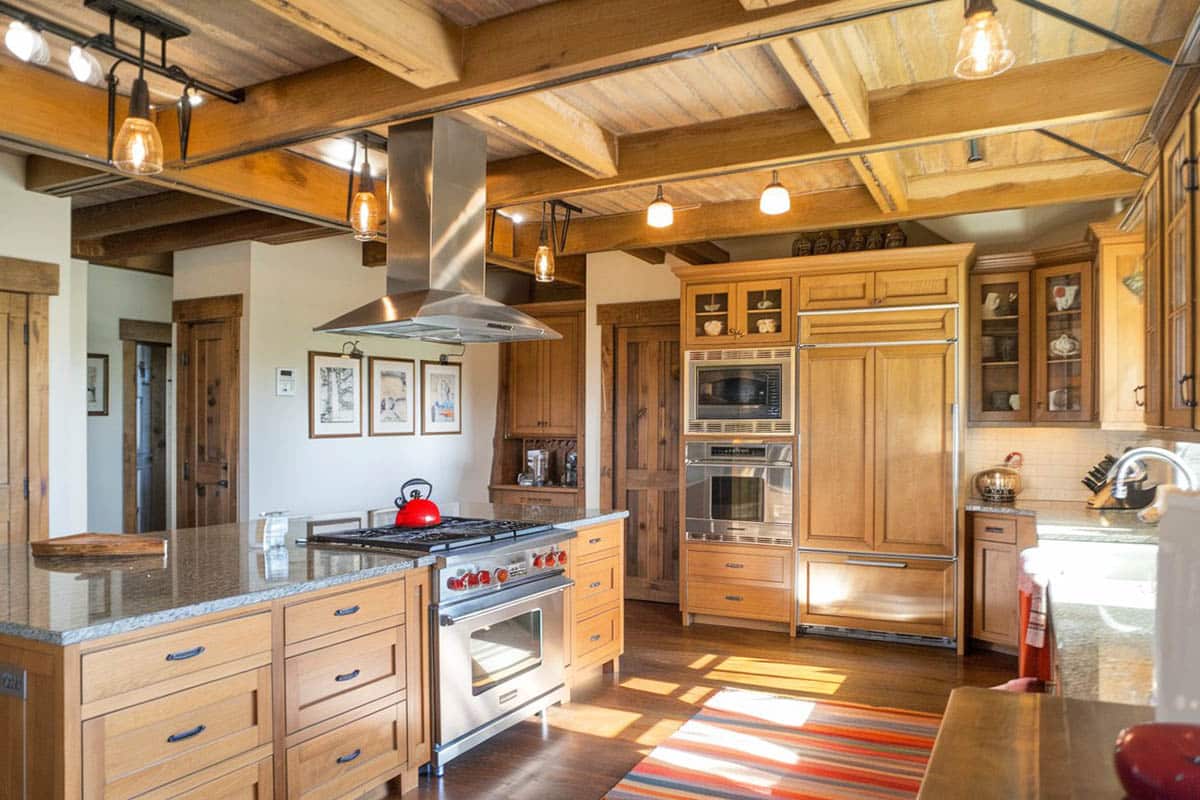
Going for a clean, modern look, this resort design exudes the elegance of classic designs yet possesses the straight & slim aspects of modern design. It has natural fruitwood floors and ceiling, while the cabinets use natural teakwood as well. The countertop material is gray granite to help neutralize the bright natural colors of the wood. Rustic pendant lighting over the island and lantern-style drop lighting provides plenty of illumination and help add to the charm of the kitchen design.
Craftsman Lighting for the Kitchen
As mentioned, the Craftsman style showcases utilitarian features and gives emphasis to straight lines and a straightforward design. This is also exhibited even in the type of lighting fixtures used for a Craftsman-style kitchen. Drop lights, pendant lights, or chandeliers are commonly used as the main light source for these types of interiors. Typically, these fixtures are placed at the center of the kitchen or just above the island. They not only illuminate the space but also serve as a stunning accessory.
Craftsman-style lighting fixtures are characterized by strong lines, simple forms, and geometric shapes. They are unornamented and exhibit practicality and functionality, too, as they stay true to the design principles of the Craftsman style. Mission-style lighting is also prevalent in this design. These types of fixtures are usually made up of ironwork, glass, and dark finishes. Mica is another material that is classically used for these types of light fixtures. Aside from pendants, sconces, and surface-mounted lights can also be used.
Tiffany lamps are also commonly used in the Craftsman style. Tiffany lamps are a type of shade that is made up of colorful pieces of glass. One of the most popular designs of the Tiffany lamp is the stained leaded glass lamp. The colored pieces of glass are usually arranged in a pattern that displays elements of nature like flowers, trees, leaves, shrubs, butterflies, dragonflies, or peacock feathers. To form these patterns and showcase these designs, colored glass is cut into geometric shapes like triangles, squares, ovals, and rectangles. The beauty of having a Tiffany lamp in a Craftsman-style kitchen is that it gives a focal point to the space without competing with the natural beauty of solid wood cabinetry. Also, its colorful design contributes accent colors to the neutral palette of a Craftsman-style design.
Craftsman Colors Used for Kitchens
The Craftsman-style is dominated by a neutral color scheme. Since it takes inspiration from nature, muted shades, earth colors, and neutrals are widely used. Examples of these are off-white, cream, grays, soft and strong shades of brown, green, rust orange, golden honey, and deep reds. Shades of brown are often reflected through the use of rich wooden cabinetry and hardwood flooring. In contrast, accent colors like a muted shade of green or rust orange are often displayed through the backsplash material.
The countertops can take any color, which ranges from soft creamy beiges and off-whites to dark browns and greens. Other subtle accent colors are also introduced to the interior using lighting fixtures or cabinet hardware and other accessories. Complementary colors may also be used to further accentuate the deep color of rich woods.
Craftsman Countertops
Natural stone countertops are also another key feature in Craftsman style kitchens. Some examples of natural stones that can be used as countertops are granite, marble, and soapstone. In general, granite is the most popular countertop material. It is composed of quartz, feldspar, and mica. This unique composition gives granite its hardness and distinct natural beauty. Aside from the stunning visual aesthetics, granite is durable, heat, stain, and scratch-resistant.
Granite is also well known for its unique appearance, which consists of flecks, speckles, veins, and striations. When used as a countertop material, go for honed or polished granite and stick to those with neutral colors like white, black, brown, or gray. You can also explore honey-colored and green granite to add more life to your Craftsman-style space.
Marble is another type of natural stone that is characterized by the appearance of freely flowing veins. It is a type of limestone that is mainly composed of the mineral calcite and other minerals like clay, mica, pyrite, quartz, and graphite. It is also a durable countertop material and has a naturally cool temperature, which keeps the workspace thermally controlled. As a countertop for a Craftsman-style culinary space, marble’s classic beauty adds natural elegance and sophistication. Its natural beauty is worth showcasing and can serve as a stunning main attraction for kitchens. When used as a countertop material for Craftsman style kitchens, choose marble which has a beige or cream color, as it complements and contrasts well with the warmth of solid wood cabinetry.
Soapstone is another type of natural stone that is mainly composed of talc. It is inherently soft, but when used as a countertop material, it is mixed with a high percentage of quartz to make it more durable and long-wearing when it comes to everyday use. Soapstone is also characterized by its ultra-smooth surface. It is resistant to acids and scratches can be repaired easily by oiling or sanding. However, what sets soapstone apart from all the rest is its unique color. The distinct quality of soapstone is that it usually has a light gray color at first and then changes into a charcoal or dark gray color once applied with mineral oil. The subtle natural color of soapstone does not deviate away from the neutral color palette of a Craftsman-style culinary space.
As a substitute for natural stone, wood is also used as a countertop material for Craftsman-style kitchens. This is the ideal choice if you want to add warmth to your kitchen’s overall look and make the space more welcoming. This countertop material is commonly used for islands – particularly those that have a contrasting color to the main cabinets- because it keeps the decor and finishes cohesively tied together.
Solid wood countertops are also highly durable and have proven to last for years. The main advantage of solid wood countertops is their versatility and highly customizable form. However, when using a solid wood countertop, make sure that the surface is properly sealed to protect it from water damage. The ideal thickness for solid wood countertops in Craftsman style spaces is 1 ½ inch or greater. Some wood species that can be used as countertops are cherry, teak, oak, and walnut.
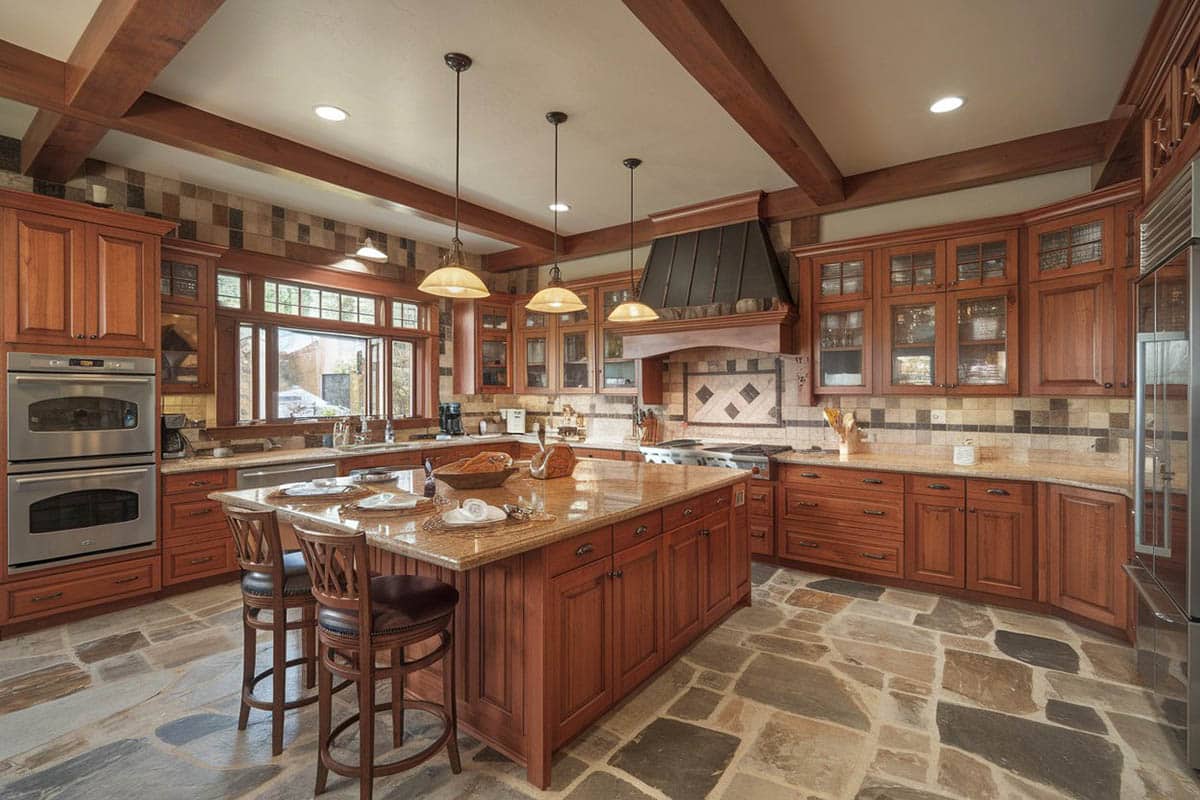
This room is warm and inviting, definitely fitting into the definition of Craftsman kitchens. Solid stone floors were combined with oak wood base cabinets, giving it a nice natural contrast. The countertop material used is granite in a reddish brown tone, which matches well with the cabinet base color. The travertine mosaic tiles on the backsplash add more depth to the colors.
Related Kitchen Design Galleries You May Like:
Mediterranean Design Kitchens – Spanish Style Kitchens– Traditional Style Kitchen Designs


